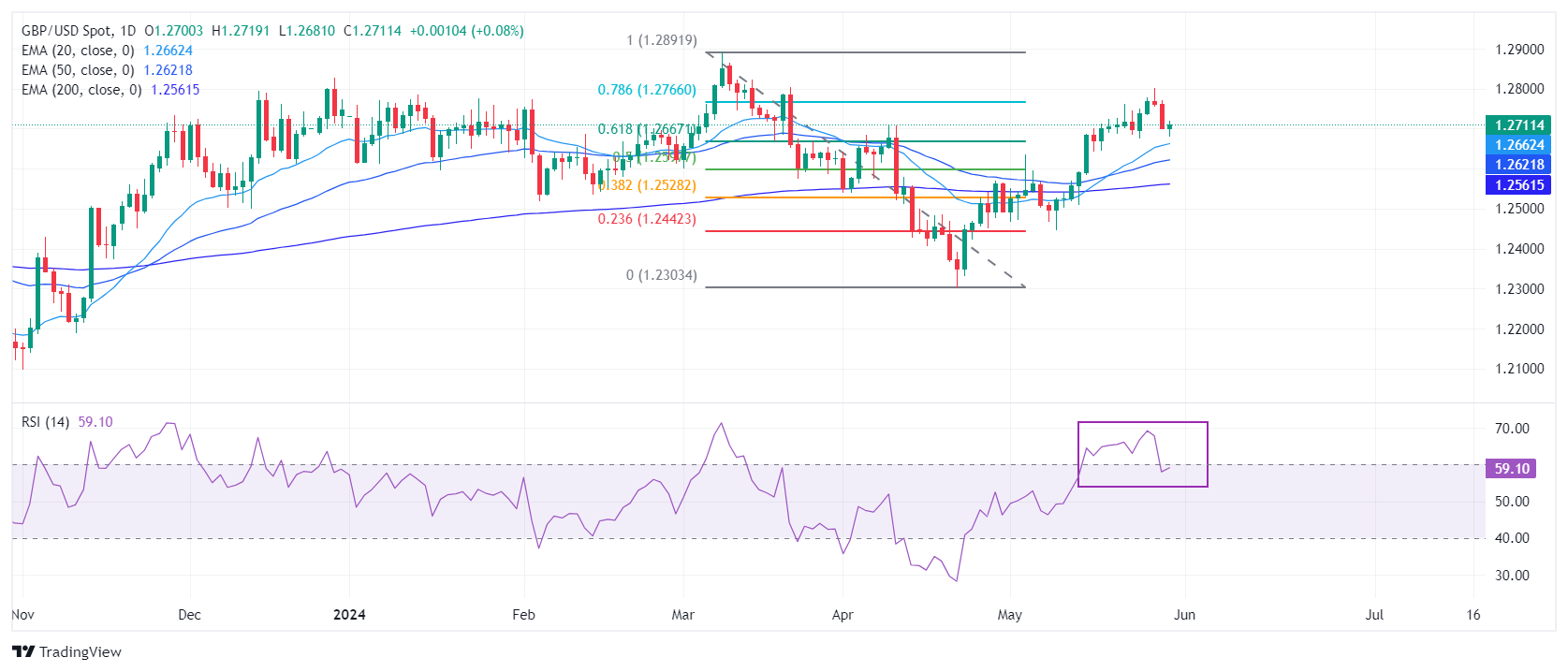Pound Sterling bounces back against US Dollar after downwardly revised US Q1 GDP

- The Pound Sterling finds a cushion below 1.2700 despite uncertainty ahead of the US core PCE Inflation.
- UK’s high service inflation remains a barrier to the sustainable return of price pressures toward the 2% target.
- Traders pare Fed rate-cut bets for September due to the stubborn inflation outlook.
The Pound Sterling (GBP) finds support below the round-level figure of 1.2700 against the US Dollar (USD) in Thursday’s New York session. The US Dollar fell sharply after the United States (US) Bureau of Labor Statistics (BLS) reported that the economy rose at a slower pace of 1.3% as per the revised estimate against the preliminary reading of 1.6%. This has weighed on the US Dollar. he US Dollar Index (DXY), which tracks the Greenback’s value against six major currencies, dropped further to 104.70.
Separately, The US Department of Labor reported the Initial Jobless Claims data for the week ending May 24. Individuals claiming jobless benefits for the first time were 219K, higher than the estimates of 218K and the prior reading of 216K, upwardly revised from 215K.
However, the near-term outlook of the GBP/USD pair is still uncertain due to cautious market sentiment ahead of the US core Personal Consumption Expenditures Price Index (PCE) data for April, which will be published on Friday.
Sterling will seldom be influenced by market speculation about Bank of England (BoE) interest rate cuts, which financial markets expect will start from the August meeting. Earlier in the year, investors anticipated the BoE would begin lowering key borrowing rates in June. However, traders pare rate-cut bets for June after the United Kingdom (UK) Consumer Price Index (CPI) report for April showed that price pressures decelerated at a slower pace than estimates.
Though UK headline CPI has significantly declined, BoE policymakers still worry about a sharp slowdown in service inflation momentum, which is almost double the pace required to bring core inflation down to the 2% target.
Daily digest market movers: Pound Sterling recovers as US Dollar corrects further
- The Pound Sterling finds support near 1.2700 amid a focus on the US core PCE Price Index data for April, which will be published on Friday. Annual and monthly core PCE inflation readings are estimated to have grown steadily by 2.8% and 0.3%, respectively.
- Investors will keenly focus on the US Federal Reserve’s (Fed) preferred inflation gauge as it will significantly influence speculation about Fed rate cuts in the September meeting. The CME FedWatch tool shows that the probability of interest rates being lower than current levels in September has come down to 47% from the previous week’s reading of 51%. Traders pare Fed rate-cut bets for September after the US Conference Board showed on Tuesday that Consumer Confidence for May surprisingly improved and the preliminary S&P Global PMI report for May outperformed expectations.
- US Consumer Confidence rose to 102.00 from 97.5 in April after deteriorating consecutively for three months. The Consumer Confidence report, which releases the Present Situation Index and the Expectations Index that reflects current and the near-term outlook, respectively, of business and labor market conditions, outperformed their prior readings.
- The Fed’s hawkish guidance on interest rates has also weighed on Fed rate-cut bets. Policymakers want to see inflation slowing for months before leaning toward the policy normalization process. Officials maintained a hawkish stance despite a slowdown in price pressures in April. They argued that a one-time decline in inflation is insufficient to get confidence that the progress in the disinflation process has resumed after stalling for the entire first quarter.
Technical Analysis: Pound Sterling seems well-supported near 61.8 Fibo retracement around 1.2670
The Pound Sterling finds temporary support slightly below 1.2700 in Thursday’s European session after a sharp sell-off on Wednesday. The near-term outlook of the GBP/USD pair is still upbeat as it holds the 61.8% Fibonacci retracement support (plotted from the March 8 high of 1.2900 to the April 22 low at 1.2300) at 1.2670. The Cable is expected to remain bullish as all short-to-long-term Exponential Moving Averages (EMAs) are sloping higher, suggesting a strong uptrend.
The 14-period Relative Strength Index (RSI) has slipped into the 40.00-60.00 range, suggesting that the momentum, which was leaned toward the upside, has faded for now.
Economic Indicator
Gross Domestic Product Annualized
The real Gross Domestic Product (GDP) Annualized, released quarterly by the US Bureau of Economic Analysis, measures the value of the final goods and services produced in the United States in a given period of time. Changes in GDP are the most popular indicator of the nation’s overall economic health. The data is expressed at an annualized rate, which means that the rate has been adjusted to reflect the amount GDP would have changed over a year’s time, had it continued to grow at that specific rate. Generally speaking, a high reading is seen as bullish for the US Dollar (USD), while a low reading is seen as bearish.
